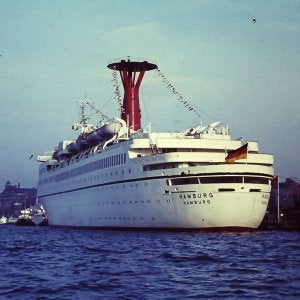Carpathia sailed from New York on schedule at 4PM on the 19th of April, 1912. She soon settled back into her normal routine as the happy and humble immigrant ship she'd always been. But things had suddenly and permanently changed, for both the ship and her crew. The story of the Titanic dominated the worlds' press for months, and Carpathias' part in the story had unintentionally moved her onto the world stage. Her Captain and crew would receive accolades from a number of various sources, including the US Congress, and the survivors themselves. Rostron would go on to serve with Cunard for nearly two more decades, and in that time, he would command some of the best known ships of the line, through peace and war. He was Knighted in 1928, and he ultimately became Commadore of the entire Cunard Fleet. Captain Arthur Rostron passed away in 1940, just nine years after his retirement from the sea.
Carpathia would meet a tragic end herself, during the final year of World War 1. She had continued on her Mediterranean service until 1915, when she was transfered to the Liverpool - New York run so she would be available to carry the tons of military supplies needed by Britain during the Great War. In addition to the freight, US troops began to be carried by the ship starting in late 1917. On July 17th 1918, she left Liverpool in a large convoy bound for New York; Carpathia, being the largest ship in the group, steamed along in the convoys centermost position. Unbeknownst to them, they were being shadowed by the German sub, U-55. Because she was the largest ship present, the subs Captain targeted her for destruction, and just after 9:00 AM, he fired a spread of three torpedos at the ship. Two of them struck in her engine room, killing three trimmers, and two firemen. The third struck her up forward, thus dooming the liner. Captain William Prothero knew his command would sink and ordered all to abandon ship. Carpathia finally went under two and half hours later, one of the last Cunard ships to be lost in World War One. There were 275 survivors of the sinking, and they were picked up by the minesweeping sloop Snowdrop, and safely returned to Liverpool. It was a sad end for this little Cunard Liner, that had come into the world through very humble origins. The same ship that only six years before her loss, had achieved virtual immortality, by accomplishing one of the most famous and dramatic rescues in maritime history.
Carpathia would meet a tragic end herself, during the final year of World War 1. She had continued on her Mediterranean service until 1915, when she was transfered to the Liverpool - New York run so she would be available to carry the tons of military supplies needed by Britain during the Great War. In addition to the freight, US troops began to be carried by the ship starting in late 1917. On July 17th 1918, she left Liverpool in a large convoy bound for New York; Carpathia, being the largest ship in the group, steamed along in the convoys centermost position. Unbeknownst to them, they were being shadowed by the German sub, U-55. Because she was the largest ship present, the subs Captain targeted her for destruction, and just after 9:00 AM, he fired a spread of three torpedos at the ship. Two of them struck in her engine room, killing three trimmers, and two firemen. The third struck her up forward, thus dooming the liner. Captain William Prothero knew his command would sink and ordered all to abandon ship. Carpathia finally went under two and half hours later, one of the last Cunard ships to be lost in World War One. There were 275 survivors of the sinking, and they were picked up by the minesweeping sloop Snowdrop, and safely returned to Liverpool. It was a sad end for this little Cunard Liner, that had come into the world through very humble origins. The same ship that only six years before her loss, had achieved virtual immortality, by accomplishing one of the most famous and dramatic rescues in maritime history.










Report